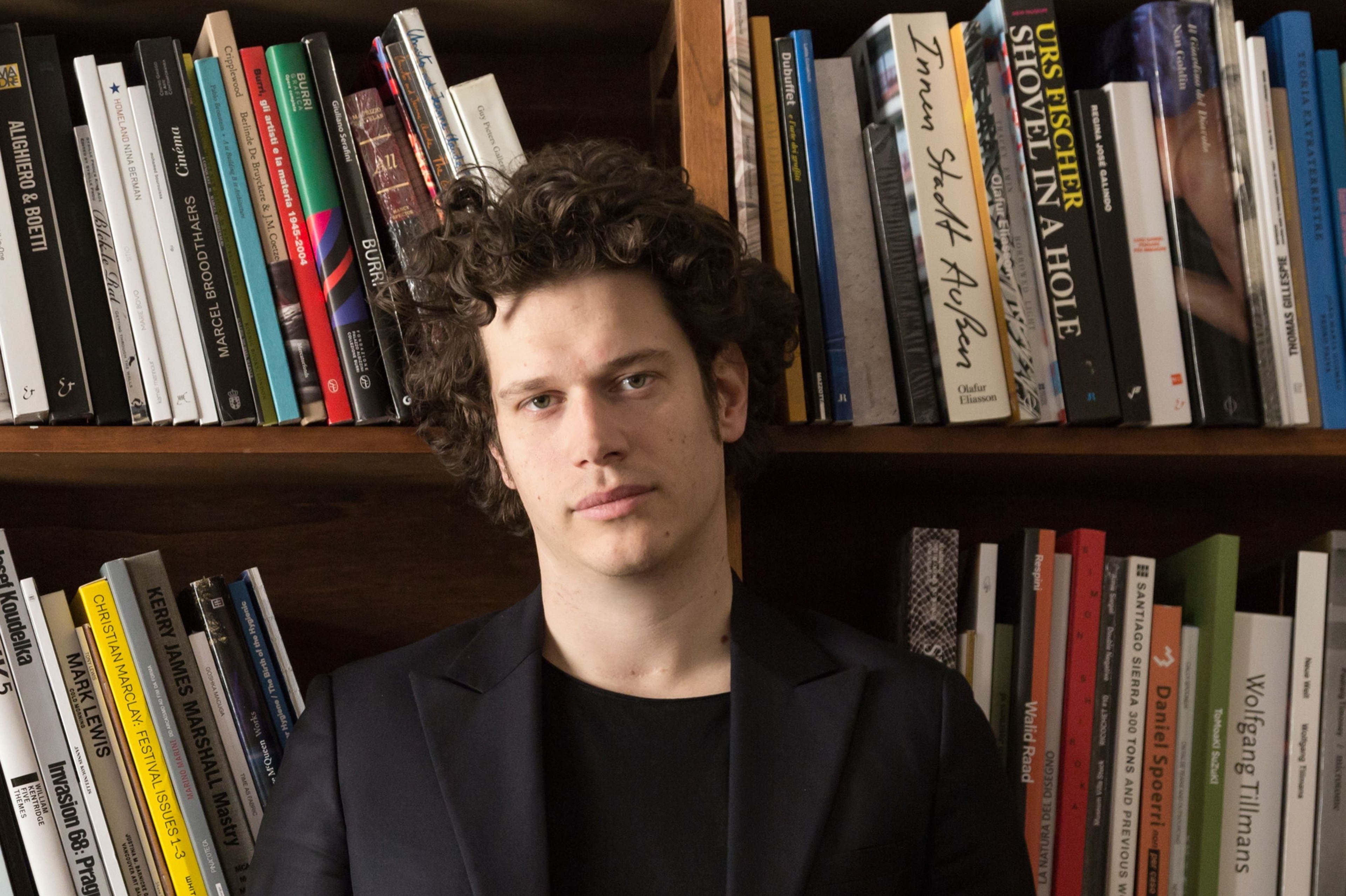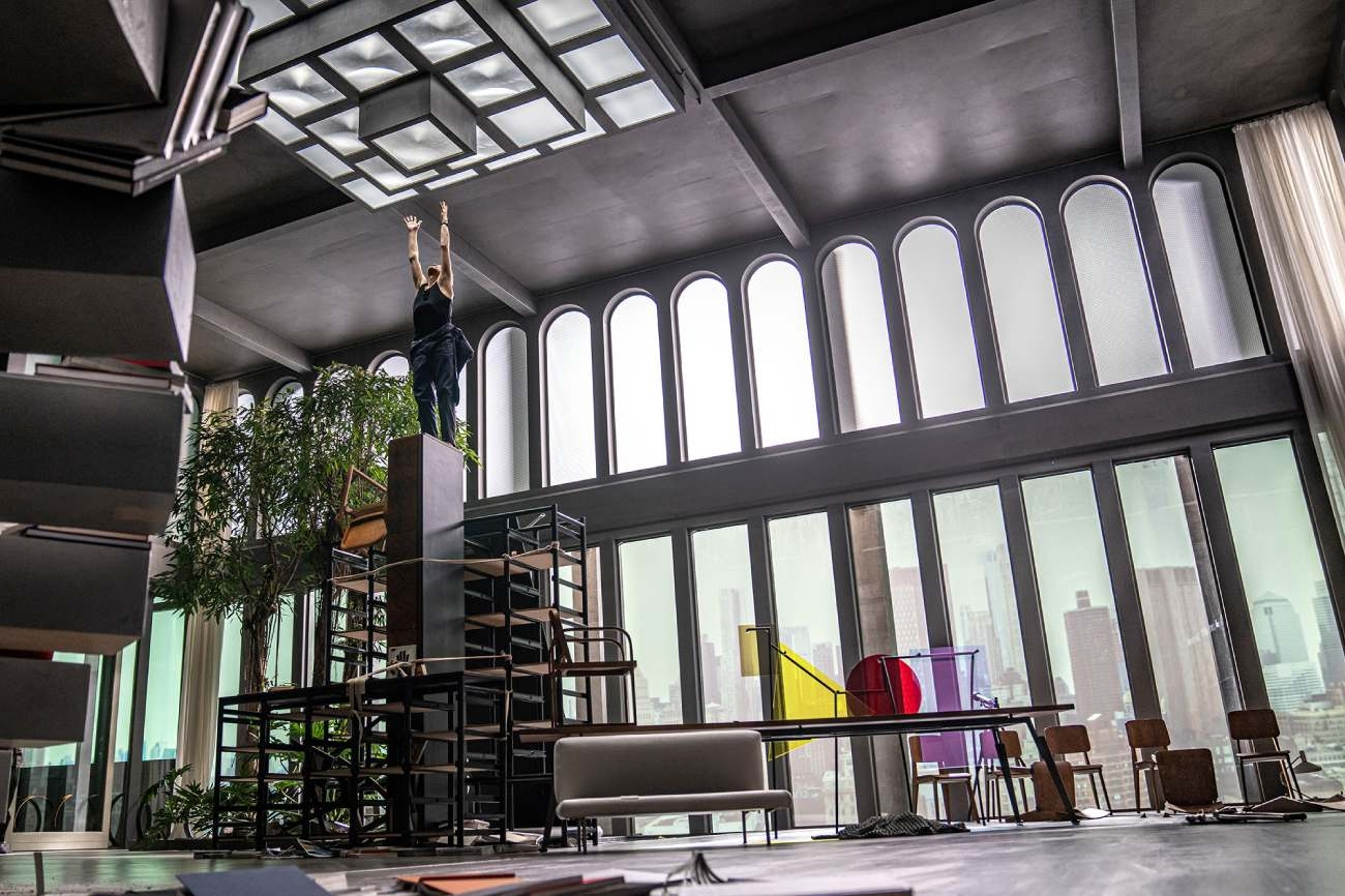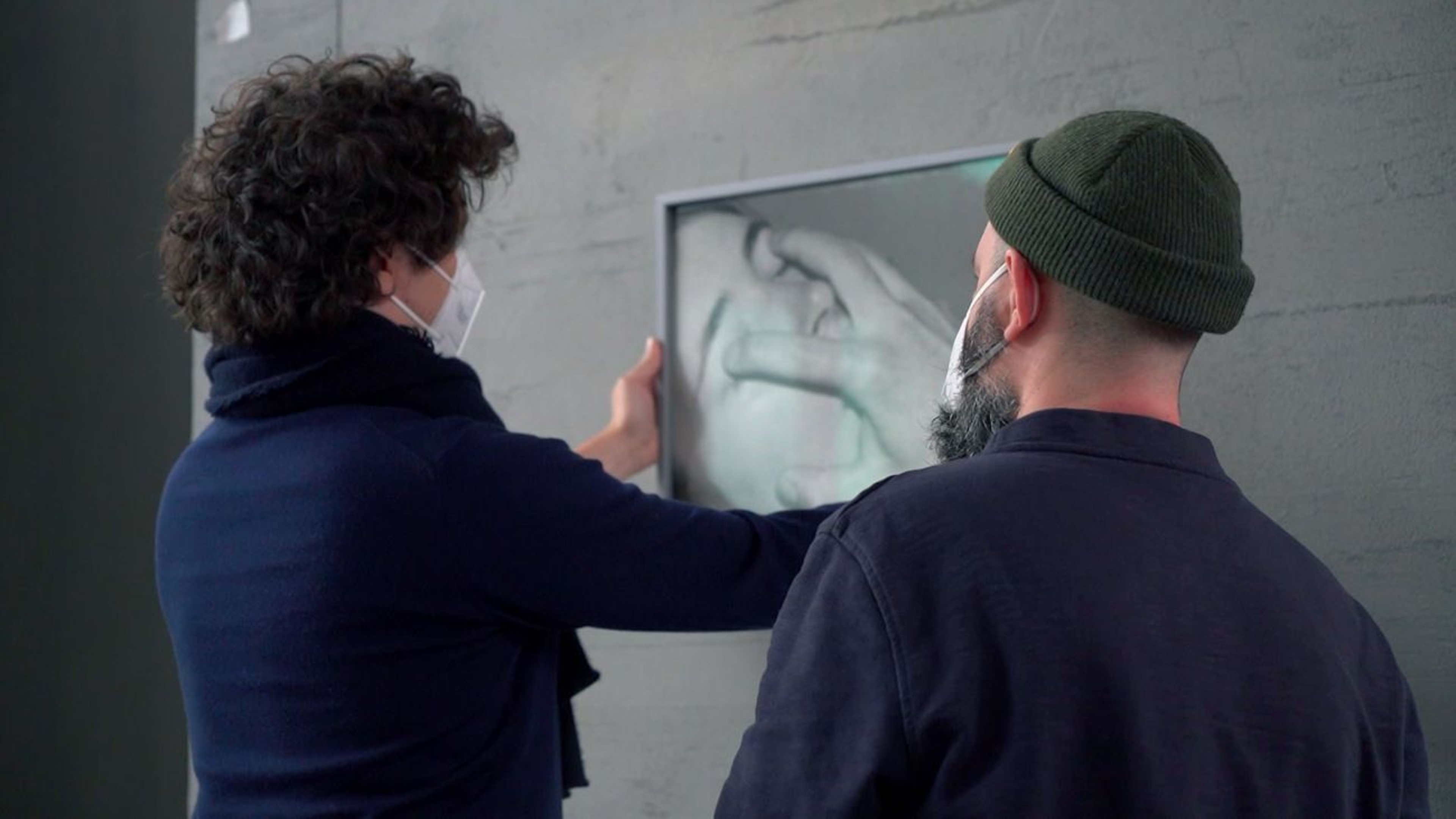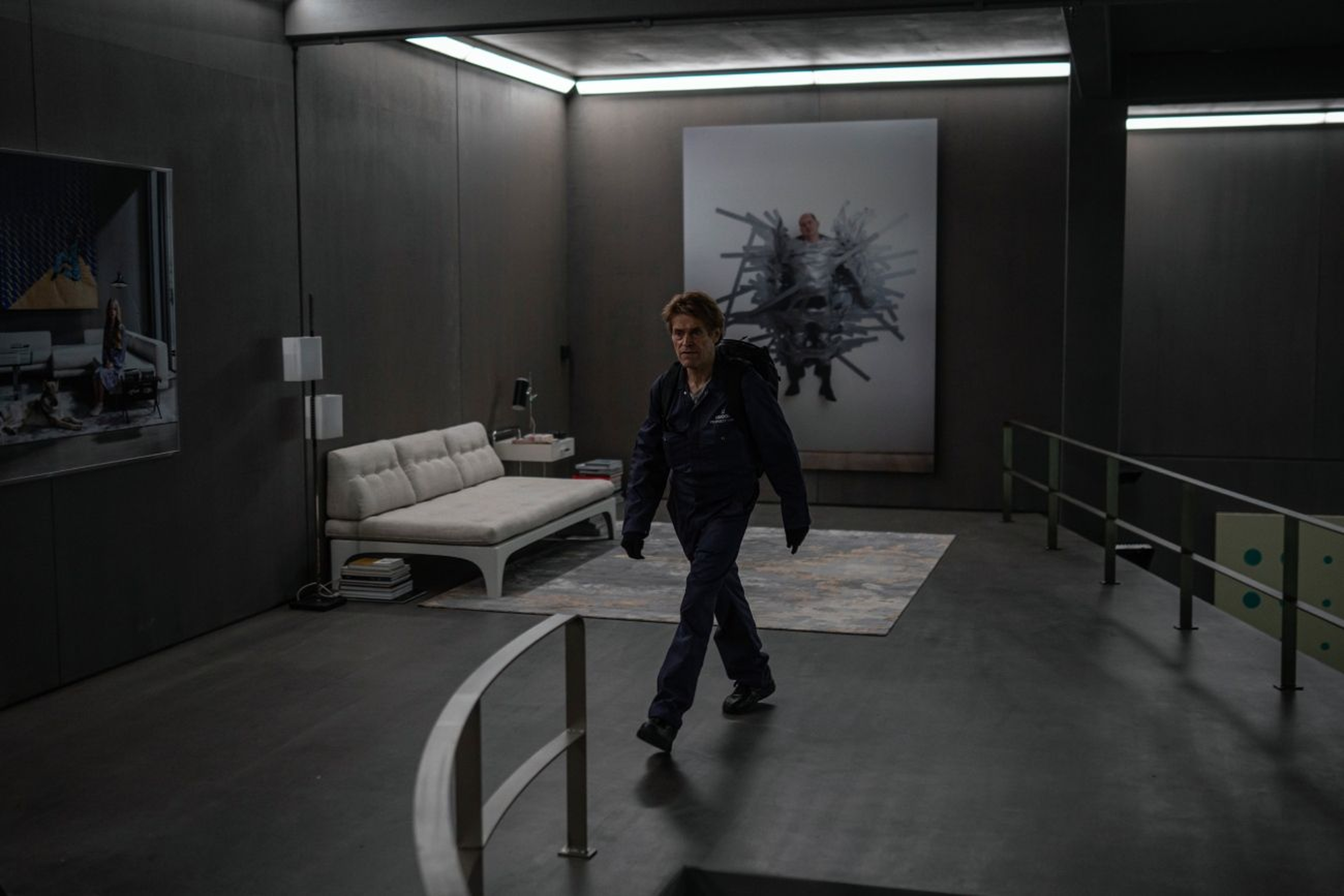In Vasilis Katsoupis’ psychological thriller Inside, Willem Dafoe plays Nemo, an art thief who has been sent into a luxury New York City penthouse to steal a range of high-end art pieces, including a rare Egon Schiele self-portrait. Unfortunately, the heist goes sideways, leaving Nemo locked inside the opulent residence, surrounded by fine art but with nothing to eat.
To give the narrative added depth, the filmmakers wanted the artwork in the film to be real and resonate with the story. “We had to approach it very seriously, in an academic way, and go for something spectacular,” explains producer Giorgos Karnavos in the production notes. The filmmakers contacted Leonardo Bigazzi, an acclaimed Italian art curator whom Karnavos had worked with before.
Bigazzi’s curated collection, including both significant contemporary works and pieces commissioned for the film, provides a secondary narrative thread. The AV Club writes, “Noteworthy is Bigazzi’s cohesiveness—the artworks he’s selected (especially a family photograph) focus on the eyes, creating a collectively spine-tingling sense that Nemo is constantly being watched from within.”
In our exclusive Q&A, Bigazzi touches on his unique role in the production, the remarkable collection of museum-quality work, and the fascinating backstory of the pieces he chose.
The official trailer for Inside

Art curator Leonardo Bigazzi
How did you get involved in curating the art that's used in Inside? How early did you get involved with the production?
It was thanks to the Greek artist Janis Rafa, with whom I had worked on several art projects with. She advised Giorgos Karnavas to contact me. I remember reading the proposal on a Sunday night at 2 a.m., and I immediately realized how extraordinary this opportunity was. In the following conversations with Giorgos and Vasilis, there was an immediate connection. I joined the project in December 2020, so only four-and-a-half months before shooting started.
What were your criteria for the work or artists you wanted to showcase in the apartment?
The focus of my work was to select artworks that build the character of the collector. At the same time, we wanted the collection to create a subtext of references that resonates with the physical and psychological condition of our protagonist. I started from the script, and from a series of real references, such as the houses of collectors I have visited over the past years.
It was important that the works would fit organically into the stunning set that Vasilis had conceived together with production designer Thorsten Sabel. With each of the 25 invited artists—or their estates—there was an in-depth dialogue about how the works would be displayed on set and their role in the narrative structure of the film. In total, there are 38 artworks in the film representing different mediums, including painting, sculpture, drawing, photography, and video.
Were there any works suggested in the script that were essential for the film?
The artworks that are the target of the thief had to be recognizable and from a well-known master. I proposed works by Egon Schiele, an artist that Vassilis had originally envisaged as part of the collection and whose tormented figures could relate to our protagonist’s physicality.
Also, two other works were present in the original script: “I can’t make you love me,” a two-screen video installation by Serbian artist Breda Beban, and “Spring” by Greek artist Stefanos Rokos. Beban was an influential art teacher at the university where Vasilis had studied. Her work was also consistent with my curatorial approach since it speaks of the impossibility of meeting, about separation, and being isolated. Rokos’ painting was commissioned for the film as a portrait of the collector with strong sexual references, as Vasilis wanted [the owner's] bedroom to represent his obsession and secret pleasures.

Amalia Pica's "Memorial for Intersections #15" on the floor in Inside
Did you use the original artwork or replicas in the film?
Some are original, but others, because they had to be destroyed or damaged during filming, are replicas often made by the artists themselves. Maurizio Cattelan and Luc Tuymans, for instance, sent us the works directly from their studios. We also had original artworks, like “The Moth” or “Do you realise there is a rainbow even if it’s night!?” by Petrit Halilaj, the oranges in “Noches en los jardines de España” by Alvaro Urbano and “Neon” by David Horvitz. These works obviously had to be made of materials that would allow for any damage so they could either be easily repaired or replaced or be coherent with the conceptual approach of the artist and become part of the life of the artwork itself as a trace of their presence on the set. After finishing the movie, some of the copies of artworks were shipped back to the artists, others were simply destroyed, and we documented the process as agreed on by the artists.
In addition to approaching artists/dealers for permission, you commissioned some original work from particular artists. How did that come about?
From the beginning, I imagined treating the curatorship for the movie as if it were a real exhibition, exploring the generative potential of the encounter between contemporary art and cinema. Therefore, despite the tight production schedule, I proposed to commission six works for the film. These included the wonderful watercolor by Francesco Clemente; the sculptures by Petrit Halilaj, Rayyane Tabet, and Alvaro Urbano; the photograph of the collector by Albrecht Fuch; and the painting by Stefanos Rokos that I mentioned before. I’m interested in the idea that these works will now exist in the world, will be exhibited, and will carry the story of the film further in different contexts.
What do you think this collection says about the mysterious man who owns the apartment?
A private art collection is always a direct expression of the people who put it together. It reveals their personality, passions, their loves, encounters, and, very often, their obsessions. Imagining this collection was like giving shape to an invisible antagonist whose presence became tangible through art. The idea was that his collection had to express a cultured and sophisticated taste, combining an interest in abstract art with works with strong political themes. However, the penthouse had to also show a certain ostentation of wealth, against which, in the course of the film, the protagonist's fury is unleashed.

Curator Leonardo Bigazzi positions Johanna Piotrowska's 'Untitled' (2014) on the set of Inside
Can you talk in detail about several of the artists whose work is in the movie?
In her “Frantic” photographs, Polish artist Joanna Piotrowska asked friends and acquaintances around the world to build shelters in their homes with their personal objects and furniture. The works mirrored what Vassilis imagined Nemo eventually constructing in the penthouse.
The series reflects on how we relate to the domestic environment in search of a space of protection and safety, which is often fragile and precarious just like the shelter that Nemo builds in the film. I think we all renegotiated the relationship with our homes during the pandemic, realizing that they can be a refuge as much as a prison, and this experience very much resonates with some of the key concepts of the film.

Willem Dafoe as Nemo in front of Maurizio Cattelan's "A Perfect Day" in Inside
“A Perfect Day” showcases an installation at Milan’s Galleria Massimo de Carlo, where artist Maurizio Cattelan duct-taped his gallerist to the wall. Conceptually, this gesture reversed the power dynamics of the gallery world: usually, it’s the gallerist that benefits from hanging the artist’s work on the walls. Cattelan here decided to do ironically and literally the opposite. For me, this piece was perfect for the collection because Nemo finds himself in a situation where he is there to steal and he ends up trapped. This idea of power structure and control is flipped. The figure in Cattelan’s work becomes a mute witness of the struggle of our tormented character until he decides to “set him free” by detaching the work from the wall.
Adrian Paci’s photograph “Centro di permanenza temporanea” [Temporary Detention Centre] (2007) depicts a group of migrants waiting on an aircraft ladder on an empty runway. The work speaks of being suspended in an alienating limbo where the hope for a better future is far from being a reality. A condition where time and space lose their meaning and life is lost in a transitory moment that becomes tragically permanent. This again perfectly mirrors Nemo’s reality trapped inside the house waiting for a change that never comes. Paci’s work is one of those artworks that inspired changes in the script, like the moving scene when Dafoe stares in front of it and cries. A part of the image even ends up materializing in the film: the airplane ladder, from which Nemo descends in his dream, was inspired by this work.
This interview has been edited and condensed for clarity.
